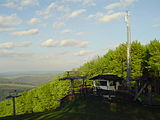Ustrzyki Dolne
Ustrzyki Dolne | |
|---|---|
 Ustrzyki Dolne panorama | |
| Coordinates:49°25′47″N22°35′12″E/ 49.42972°N 22.58667°E | |
| Country | |
| Voivodeship | |
| County | Bieszczady |
| Gmina | Ustrzyki Dolne |
| Established | 16th century |
| Town rights | 1727 |
| Government | |
| • Mayor | Michał Wnuk |
| Area | |
| • Total | 16.79 km2(6.48 sq mi) |
| Elevation | 480 m (1,570 ft) |
| Population (2006) | |
| • Total | 9,478 |
| • Density | 560/km2(1,500/sq mi) |
| Time zone | UTC+1(CET) |
| • Summer (DST) | UTC+2(CEST) |
| Postal code | 38-700 to 38-714 |
| Area code | +48 13 |
| Car plates | RBI |
| Website | Official website |
 | |
Ustrzyki Dolne(pronounced[usˈtʂɨkʲiˈdɔlnɛ];Yiddish:Istrik,Ukrainian:Устри́ки-Долі́шні,romanized:Ustrýky-Dolíshni) is a town in south-easternPoland,situated in theSubcarpathian Voivodeship(since 1999) close to the border withUkraine.It is the capital ofBieszczady County,with 9,383 inhabitants(02.06.2009).[1]
In existence since the 15th century, Ustrzyki received its city charter around 1727. During theFirst Partition of Poland,in 1772 it became part of theHabsburg monarchywhere it remained until 1918. After the defeat of Austria-Hungary Ustrzyki became part of thenewly independent Poland.Major growth of the Ustrzyki economy began in the 19th century, when a railway connection toPrzemyślandSanokwas built in 1872, and the exploitation of localoil fieldsbegan. Temporarily in theUSSRafter theVistula–Oder Offensivein 1944–45, it became part of postwar Poland following the1951 Polish-Soviet territorial exchange.[2]
The wordDolnemeansLower.There exists a villageUstrzyki Górne-Upper.
Timeline of history
[edit]
- 1497, Foundation of Ustrzyki Dolne as a royal village in the district Przemyśl
- 1723, Old town is built. First Jews appear in the town
- 1772, Ustrzyki Dolne together withGaliciabecomes part of theAustrian Empire
- 1800–1850, Ustrzyki Dolne is part of the districtSanok(Königreich Galizien)
- 1850–1918, Ustrzyki Dolne is part of the district Lisko
- During World War I, Ustrzyki Dolne was occupied for six months by the Russian army and in 1918 for two months by Ukrainian troops.
- 1919–1939, Ustrzyki Dolne is part of theLwów Voivodeship.On 1 January 1939 in city lived 4,300 residents (550 Ukrainians, 1,150 Polish people, 2,600 Jews).[3]
- 1939 September, Occupation by German troops. 100 Jews are killed. Soon transferred toSoviet Unionas part of theMolotov–Ribbentrop Pact
- 1939–1941, Soviet annexation. Part of theDrohobych Oblast
- 1941–1944, German occupation. The city is initially taken by Slovak troops and transferred under the German administration. Jewish population is killed in the town or deported toBelzecwhere they are immediately gassed. Probably only ten or fewer of Ustrzyki Dolne's prewar Jewish population survived the war.
- 1944–1951, Soviet administration. Part of theDrohobych Oblast
- 1951–1974, As part of aland swapwith the Soviet Union, Ustrzyki Dolne becomes Polish again and is part of the province Rzeszów.
- 1974–1998, Ustrzyki Dolne becomes part of theKrosno Voivodeship.
- 1998, Ustrzyki Dolne becomes part of the Subcarpathian Voivodeship (capitalRzeszów)
Points of interest
[edit]-
Ustrzyki seen from Gromadzyń
-
Ski Lift Station at Laworta
-
Greek-Catholic church in Ustrzyki Dolne
International relations
[edit]Twin towns — Sister cities
[edit]Ustrzyki Dolne istwinnedwith:
References
[edit]![]() Media related toUstrzyki Dolneat Wikimedia Commons
Media related toUstrzyki Dolneat Wikimedia Commons
- Notes
- ^"Population. Size and structure by territorial division"(PDF).Central Statistical Office, 00-925 Warsaw. 2009-06-02.Index.Retrieved2009-06-22.
- ^History of Ustrzyki Dolne, Official website(in Polish)
- ^Volodymyr Kubiyovych.Етнічні групи південнозахідної України (Галичини) на 1.1.1939.— Wiesbaden, 1983. — p. 41.







